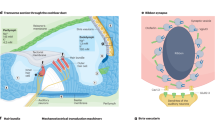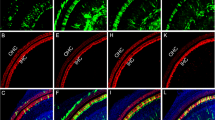Abstract
Hearing impairment is the most common sensory disorder, with congenital hearing impairment present in approximately 1 in 1,000 newborns 1 . Hereditary deafness is often mediated by the improper development or degeneration of cochlear hair cells 2 . Until now, it was not known whether such congenital failures could be mitigated by therapeutic intervention 3, 4, 5 . Here we show that hearing and vestibular function can be rescued in a mouse model of human hereditary deafness. An antisense oligonucleotide (ASO) was used to correct defective pre-mRNA splicing of transcripts from the USH1C gene with the c.216G>A mutation, which causes human Usher syndrome, the leading genetic cause of combined deafness and blindness 6, 7 . Treatment of neonatal mice with a single systemic dose of ASO partially corrects Ush1c c.216G>A splicing, increases protein expression, improves stereocilia organization in the cochlea, and rescues cochlear hair cells, vestibular function and low-frequency hearing in mice. These effects were sustained for several months, providing evidence that congenital deafness can be effectively overcome by treatment early in development to correct gene expression and demonstrating the therapeutic potential of ASOs in the treatment of deafness.
This is a preview of subscription content, access via your institution
Access options
Subscribe to this journal
Receive 12 print issues and online access
$209.00 per year
only $17.42 per issue
Buy this article
- Purchase on Springer Link
- Instant access to full article PDF
Prices may be subject to local taxes which are calculated during checkout




Similar content being viewed by others
References
Morton, C.C. & Nance, W.E. Newborn hearing screening—a silent revolution. N. Engl. J. Med. 354, 2151–2164 (2006).
Dror, A.A. & Avraham, K.B. Hearing loss: mechanisms revealed by genetics and cell biology. Annu. Rev. Genet. 43, 411–437 (2009).
Conde de Felipe, M.M., Feijoo Redondo, A.F., Garcia-Sancho, J., Schimmang, T. & Alonso, M.B. Cell- and gene-therapy approaches to inner ear repair. Histol. Histopathol. 26, 923–940 (2011).
Di Domenico, M. et al. Towards gene therapy for deafness. J. Cell. Physiol. 226, 2494–2499 (2011).
Bermingham-McDonogh, O. & Reh, T.A. Regulated reprogramming in the regeneration of sensory receptor cells. Neuron 71, 389–405 (2011).
Bitner-Glindzicz, M. et al. A recessive contiguous gene deletion causing infantile hyperinsulinism, enteropathy and deafness identifies the Usher type 1C gene. Nat. Genet. 26, 56–60 (2000).
Verpy, E. et al. A defect in Harmonin, a PDZ domain-containing protein expressed in the inner ear sensory hair cells, underlies Usher syndrome type 1C. Nat. Genet. 26, 51–55 (2000).
Kimberling, W.J. et al. Frequency of Usher syndrome in two pediatric populations: Implications for genetic screening of deaf and hard of hearing children. Genet. Med. 12, 512–516 (2010).
Ouyang, X.M. et al. Characterization of Usher syndrome type I gene mutations in an Usher syndrome patient population. Hum. Genet. 116, 292–299 (2005).
Ebermann, I. et al. Deafblindness in French Canadians from Quebec: a predominant founder mutation in the USH1C gene provides the first genetic link with the Acadian population. Genome Biol. 8, R47 (2007).
Ouyang, X.M. et al. USH1C: a rare cause of USH1 in a non-Acadian population and a founder effect of the Acadian allele. Clin. Genet. 63, 150–153 (2003).
Lentz, J. et al. The USH1C 216G→A splice-site mutation results in a 35-base-pair deletion. Hum. Genet. 116, 225–227 (2005).
Lentz, J., Pan, F., Ng, S.S., Deininger, P. & Keats, B. Ush1c216A knock-in mouse survives Katrina. Mutat. Res. 616, 139–144 (2007).
Lentz, J.J. et al. Deafness and retinal degeneration in a novel USH1C knock-in mouse model. Dev. Neurobiol. 70, 253–267 (2010).
Hardisty-Hughes, R.E., Parker, A. & Brown, S.D. A hearing and vestibular phenotyping pipeline to identify mouse mutants with hearing impairment. Nat. Protoc. 5, 177–190 (2010).
Michalski, N. et al. Harmonin-b, an actin-binding scaffold protein, is involved in the adaptation of mechanoelectrical transduction by sensory hair cells. Pflugers Arch. 459, 115–130 (2009).
Grillet, N. et al. Harmonin mutations cause mechanotransduction defects in cochlear hair cells. Neuron 62, 375–387 (2009).
Lefèvre, G. et al. A core cochlear phenotype in USH1 mouse mutants implicates fibrous links of the hair bundle in its cohesion, orientation and differential growth. Development 135, 1427–1437 (2008).
Boëda, B. et al. Myosin VIIa, harmonin and cadherin 23, three Usher I gene products that cooperate to shape the sensory hair cell bundle. EMBO J. 21, 6689–6699 (2002).
Peng, A.W., Salles, F.T., Pan, B. & Ricci, A.J. Integrating the biophysical and molecular mechanisms of auditory hair cell mechanotransduction. Nat. Commun. 2, 523 (2011).
Müller, M., von Hunerbein, K., Hoidis, S. & Smolders, J.W. A physiological place-frequency map of the cochlea in the CBA/J mouse. Hear. Res. 202, 63–73 (2005).
Greenwood, D.D. A cochlear frequency-position function for several species—29 years later. J. Acoust. Soc. Am. 87, 2592–2605 (1990).
Hua, Y. et al. Peripheral SMN restoration is essential for long-term rescue of a severe spinal muscular atrophy mouse model. Nature 478, 123–126 (2011).
Wheeler, T.M. et al. Targeting nuclear RNA for in vivo correction of myotonic dystrophy. Nature 488, 111–115 (2012).
El-Amraoui, A. & Petit, C. Usher I syndrome: unravelling the mechanisms that underlie the cohesion of the growing hair bundle in inner ear sensory cells. J. Cell Sci. 118, 4593–4603 (2005).
Petit, C. & Richardson, G.P. Linking genes underlying deafness to hair-bundle development and function. Nat. Neurosci. 12, 703–710 (2009).
Hall, J.W. III. Development of the ear and hearing. J. Perinatol. 20, S12–S20 (2000).
Uhlmann, R.A., Taylor, M., Meyer, N.L. & Mari, G. Fetal transfusion: the spectrum of clinical research in the past year. Curr. Opin. Obstet. Gynecol. 22, 155–158 (2010).
Baker, B.F. et al. 2′-O-(2-methoxy)ethyl–modified anti-intercellular adhesion molecule 1 (ICAM-1) oligonucleotides selectively increase the ICAM-1 mRNA level and inhibit formation of the ICAM-1 translation initiation complex in human umbilical vein endothelial cells. J. Biol. Chem. 272, 11994–12000 (1997).
Hastings, M.L. et al. Tetracyclines that promote SMN2 exon 7 splicing as therapeutics for spinal muscular atrophy. Sci. Transl. Med. 1, 5ra12 (2009).
Hardie, N.A., MacDonald, G. & Rubel, E.W. A new method for imaging and 3D reconstruction of mammalian cochlea by fluorescent confocal microscopy. Brain Res. 1000, 200–210 (2004).
Sage, C., Venteo, S., Jeromin, A., Roder, J. & Dechesne, C.J. Distribution of frequenin in the mouse inner ear during development, comparison with other calcium-binding proteins and synaptophysin. Hear. Res. 150, 70–82 (2000).
Milliken, G.A. & Johnson, D.E. Analysis of Messy Data Volume I: Designed Experiments Ch. 30, 413–423 (Lifetime Learning Publications, Belmont, California, 1984).
Edwards, D. & Berry, J.J. The efficiency of simulation-based multiple comparisons. Biometrics 43, 913–928 (1987).
Acknowledgements
We gratefully acknowledge support from the Hearing Health Foundation, Midwest Eye-Banks, the National Organization for Hearing Research Foundation, Capita Foundation and the US National Institutes of Health. We thank D. Cunningham and E. Rubel for assistance with scanning electron microscopy analysis; A. Rosenkranz, R. Marr and M. Oblinger for use of equipment; J. Huang for assistance with open-field analysis, L. Ochoa for assistance with ABR analysis computer support, G. MacDonald for assistance with confocal imaging and deconvolution analysis, U. Wolfrum (Johannes Gutenberg University of Mainz) for harmonin b–specific antibodies, H. Thompson for statistical analysis, and A. Case, B. Keats and M. Havens for discussions and comments on the manuscript.
Author information
Authors and Affiliations
Contributions
The project was conceived of by M.L.H. Experiments were designed and performed by A.J.H., F.M.J., J.J.L., K.E.M., M.L.H. and D.M.D., and were analyzed by M.L.H., J.J.L., F.R., F.M.J., A.J.H. and K.E.M. Animal work was carried out by M.L.H., D.M.D., K.E.M., A.J.H., F.M.J., J.J.L. and M.J.S. Molecular experiments were performed by A.J.H., F.M.J., K.E.M. and M.L.H. J.J.L. carried out the immunofluorescence analysis. J.J.L., M.J.S. and H.E.F. performed auditory brainstem response experiments, and J.J.L. and N.G.B. interpreted the results. M.L.H. and J.J.L. wrote the paper.
Corresponding authors
Ethics declarations
Competing interests
F.R. may materially benefit financially through stock options in Isis Pharmaceuticals. M.L.H. and F.R. have patents pending with the United States Patent and Trademark Office for the ASOs and the targeting approach.
Supplementary information
Supplementary Text and Figures
Supplementary Figures 1–10 and Supplementary Table 1 (PDF 3338 kb)
Supplementary Video 1
Ush1c.216AA mice treated with ASO-29. This video shows four 1-month-old mice. Two representative heterozygous (Ush1c.216GA) mice (top row) and homozygous mutant mice (Ush1c.216AA) (bottom row), one of each group treated with ASO-C (left) and one with ASO-29 (right). The ASO-C treated mutant exhibits characteristic circling behavior and hyperactivity (bottom left), whereas the ASO-29-treated mouse (bottom right) is indistinguishable from the heterozygous mice (top). (MOV 2547 kb)
Supplementary Video 2
Behavioral response to acoustic stimuli in Ush1c.216AA mice treated with ASO-29. This video shows four 2-month-old mice. Two representative heterozygous (Ush1c.216GA) mice (top row) and homozygous mutant mice (Ush1c.216AA) (bottom row), one of each group treated with ASO-C (left) and one with ASO-29 (right). Opaque dividers were inserted between the cages to blind the mice to each other. A whistle blow (∼3-16 kHz and 90-110 dB SPL; Supplementary Fig. 6) was activated after acclimation to the environment. This acoustic stimulus occurs 2.9 s into the video and persists for 0.9 s. A startle response, indicated by a rapid body movement, followed by freezing (a period of watchful immobility), suggests, qualitatively, that the heterozygote mice (GA) and the mutant 216AA mouse treated with ASO-29 could hear the acoustic stimulation. The 216AA mutant mouse treated with ASO-C showed no visible response to the acoustic stimulus. (MOV 2776 kb)
Rights and permissions
About this article
Cite this article
Lentz, J., Jodelka, F., Hinrich, A. et al. Rescue of hearing and vestibular function by antisense oligonucleotides in a mouse model of human deafness. Nat Med 19, 345–350 (2013). https://doi.org/10.1038/nm.3106
Received:
Accepted:
Published:
Issue Date:
DOI: https://doi.org/10.1038/nm.3106



